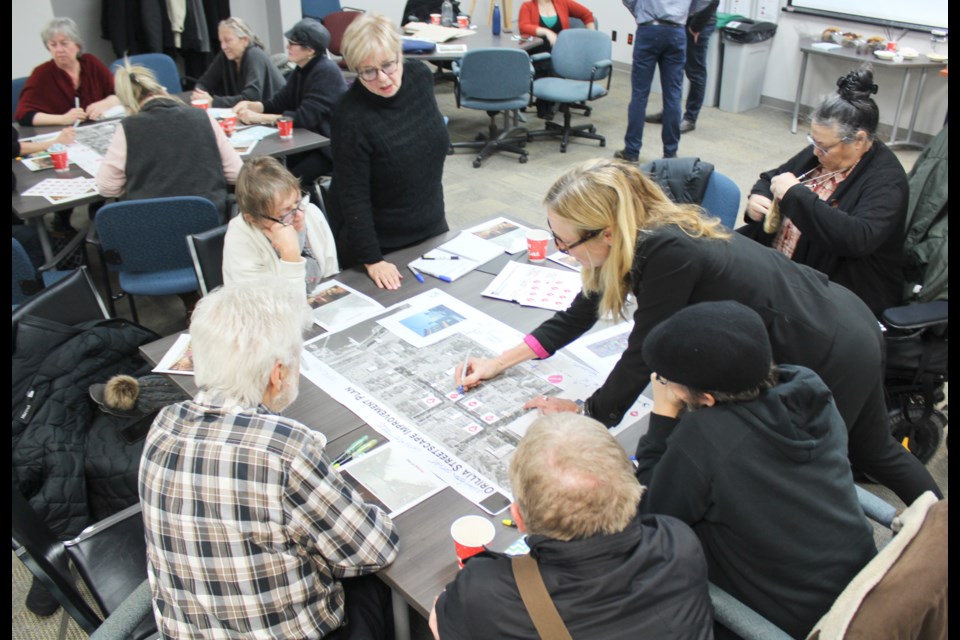Traffic or no traffic? Cobblestone or pavement? More public art or stick with what we have?
Those were just a few of the questions discussed at Thursday’s public workshop at the Orillia City Centre, where more than 30 people showed up to learn about potential changes to Orillia’s streetscapes.
The workshop included suggestions gathered from a similar “visioning exercise” in August.
Consultants with Stantec had created illustrations of what a transformed downtown Orillia might look like. There was a heavy emphasis on “flex streets.”
“Flex streets typically remove traditional gutters and curbs in order to provide smooth transitions between shop fronts, pedestrian, planting, and vehicle zones,” Stantec explained in an earlier report. “These changes improve the pedestrian and cycling experience, whilst simultaneously accommodating daily car traffic, short-term drop-offs, and parking.”
In short: Flex streets aim to create harmony among traffic and pedestrians, in an esthetically pleasing way that includes narrower traffic lanes, plenty of sidewalk space and no marked traffic lanes.
“The idea is the pedestrian, the wheelchair, the stroller, whatever — we’re in this together,” said Brenda Webster Tweel, senior associate with Stantec.
Thursday’s workshop saw groups of people drawing or placing stickers on maps of the downtown core to indicate what they’d like to see and where they’d like to see it. Susan Langlois’s table seemed to be on the same page.
“We’re all saying there’s no reason for traffic on Mississaga Street” and part of Peter Street, Langlois said, adding the parallel Colborne and Coldwater streets will provide adequate access to the waterfront under the plan presented Thursday. “It’s about safety and it would increase business flow. More pedestrians bring more business. They wander more.”
The idea of permanently closing Mississaga Street to vehicular traffic is getting a cool reception from downtown business owners, according to Michael Knight, chair of the Downtown Orillia Management Board.
“Any good planner in North America is going to tell you that if you take traffic off the street, you’re going to have no business,” he said.
About 40 years ago, the city shut the main street down to vehicular traffic for an entire summer and “it went over very poorly,” Knight said.
“We still live in an area where a lot of people come from (a distance) to visit. They don’t walk here. They drive their cars here,” he said.
Self-driving cars aren’t a reality in Orillia yet, and “until that time comes, people still want to park as close as they can,” Knight said.
Langlois, however, sees potential for Orillia’s downtown and waterfront. That’s one of the reasons she and her husband, Tom, chose to retire here from Bolton.
“We have so many opportunities to draw people here from Huntsville to the north and Toronto to the south,” she said. “Don’t think about cars. Think about people.”
The recommendations from Stantec include maintaining two-way traffic on Mississaga Street, establishing defined bicycle routes, creating flex streets on Mississaga from Andrew to Front streets and on Peter from Mississaga to Colborne, creating a “water feature” between the foot of Colborne Street and Lake Couchiching, and employing the use of Silva Cells.
Silva Cells are frames that are installed below the ground. They keep soil loose and prevent tree roots from pushing up the surface, heaving sidewalks — an issue that is now evident downtown.
The proposal for Orillia is to make use of Silva Cells, maintain as many existing trees as possible, add more trees and remove some of the existing ones that might not work with a system of Silva Cells.
“We look at trees as infrastructure,” Webster Tweel said, likening them to air conditioners in the heat and umbrellas in the rain.
The plan also calls for a reimagining of alleyways and parking lots. Stantec feels there’s an opportunity to make those spaces multi-use, in a way, and incorporate public art.
The idea garnered some support at Fred Larsen’s table.
“There should be other areas where people can sit down and perhaps look at some public art,” Larsen said.
The concept of flex streets was also well received.
“In my travels, I’ve seen a number of very attractive areas that include people-friendly places,” he said.
Stantec will soon meet with city staff to review the feedback from Thursday’s workshop “and fine-tune some of the concepts,” said Jeff Duggan, the city’s senior planner.
The next step will be presenting a report to council. Duggan hopes to have the plan finalized, with council support in principle, by the end of March.
He expects it could be five to eight years before the city gets around to the streetscapes project. Reconstruction of Front Street is first on the to-do list, followed by Centennial Drive.
